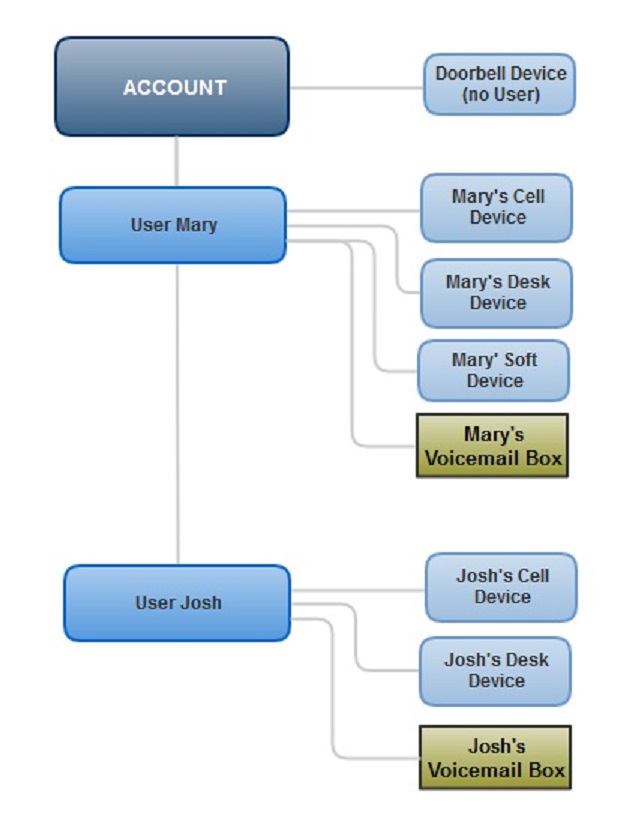Difference between revisions of "PBX Basic Concepts"
(Blanked the page) |
|||
| Line 1: | Line 1: | ||
== Users and Devices == | |||
In PBX, we consider a device anything that someone might be given to make phone calls, send SMS messages, send Faxes, etc. A device is a physical device. Unlike other systems, devices are not inherently tied to a user. You must do this yourself. | |||
In Kazoo, we consider a user the concept of a person. Users ultimately have, or "own", devices and voicemail boxes. A user can have multiple voicemail boxes and devices. Sending a phone call to a user rings all of the user's devices. And we deal with extensions in a total different way then u may be used to. Extensions don´t really exist, and yet everything can be an extension. Extension numbers can be created in the callflow app just as u would use a DID/Phone-number, thus creating a very flexible way to implement extension numbers to connect to your devices, other callflows, users and .... | |||
To keep it simple: If u require extensions for your devices or users, u can create those in the callflow app, or via the API. | |||
Consider this diagram which displays the most common use case: | |||
[[File:Basic_concept.jpg]] | |||
In the above scenario, the doorbell device is standalone. It has no user, which means no voicemail and no other features tied to it. This is fine - it can still make and receive calls, but no relationships exist. | |||
In the above scenario, Mary and Josh have multiple phones. You can ring Mary or Josh via a call-flow phone number, and if their devices ever change their calls will still work. This is important to understand because it means Mary and Josh can manage their own devices without bugging the IT guy. As long as their calls are routed to them as a user, they can access the list of devices they have in their own user portal. So when Mary or Josh change their phone number or get a new phone, they can start using that device without contacting their PBX administrator. | |||
Latest revision as of 19:59, 11 December 2017
Users and Devices
In PBX, we consider a device anything that someone might be given to make phone calls, send SMS messages, send Faxes, etc. A device is a physical device. Unlike other systems, devices are not inherently tied to a user. You must do this yourself.
In Kazoo, we consider a user the concept of a person. Users ultimately have, or "own", devices and voicemail boxes. A user can have multiple voicemail boxes and devices. Sending a phone call to a user rings all of the user's devices. And we deal with extensions in a total different way then u may be used to. Extensions don´t really exist, and yet everything can be an extension. Extension numbers can be created in the callflow app just as u would use a DID/Phone-number, thus creating a very flexible way to implement extension numbers to connect to your devices, other callflows, users and .... To keep it simple: If u require extensions for your devices or users, u can create those in the callflow app, or via the API. Consider this diagram which displays the most common use case:
In the above scenario, the doorbell device is standalone. It has no user, which means no voicemail and no other features tied to it. This is fine - it can still make and receive calls, but no relationships exist. In the above scenario, Mary and Josh have multiple phones. You can ring Mary or Josh via a call-flow phone number, and if their devices ever change their calls will still work. This is important to understand because it means Mary and Josh can manage their own devices without bugging the IT guy. As long as their calls are routed to them as a user, they can access the list of devices they have in their own user portal. So when Mary or Josh change their phone number or get a new phone, they can start using that device without contacting their PBX administrator.

